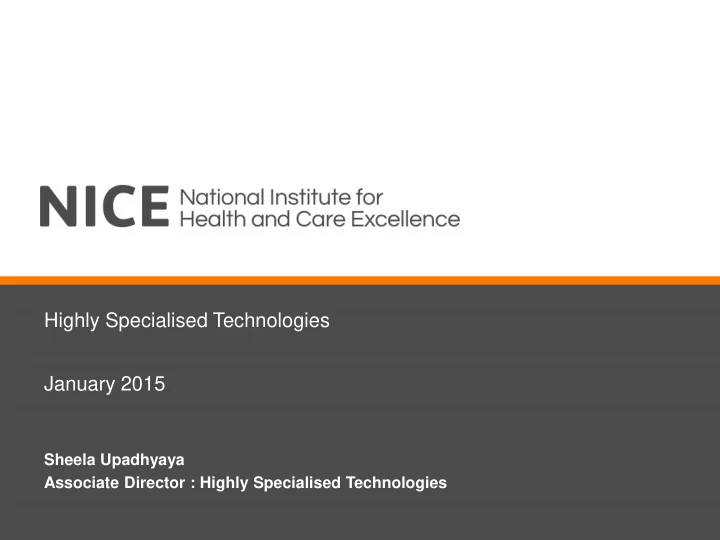

Highly Specialised Technologies January 2015 Sheela Upadhyaya Associate Director : Highly Specialised Technologies
HST at NICE • NICE took over the responsibility of the evaluation of very high cost drugs for patients with rare conditions in April 2013 • This was to ensure there was a robust, independent and transparent assessment of these drugs. 2
HST remit • To evaluate the benefits and costs of “technology x” within its marketing authorisation for the treatment of “disease y” for national commissioning by NHS England. 3
Topic Selection & Scoping Process starts Suggestions received from topic sources Reject approximately 2 years or refer before a drug is licensed Suggestions are assessed according to NICE/DH criteria elsewhere to prioritise topics e.g. Decision point 1 National Screening Committee DH/NICE jointly agree on topics that should proceed to draft scope creation Decision point 2 DH/NICE/NHS England jointly agree on draft scopes to be issued for consultation Decision point 3 Consultation on the draft scope and scoping workshop DH/NICE/NHS England post-scoping meeting Decision point 4 Ideally 12 – 15 months Referral by Minister before a drug is licensed Decision point 5
HST evaluation criteria • Nature of the condition • Impact of the new technology • Cost to the NHS and Personal Social Services • Value for money • Impact of the technology beyond direct health benefits • Impact of the technology on the delivery of the specialised service 5
Challenges associated with economic evaluation of orphan drugs • Orphan drugs do not usually prove to be cost-effective based on HTA methods designed for conventional diseases • Rarity means weight of evidence is not the same as for conventional diseases Small, heterogeneous populations Short duration of follow-up of studies Limited scientific understanding/ consensus on clinical endpoints Limited hard clinical outcomes such as survival Limited natural history data Lack of consensus/data on comparators • More to decision-making rather than strict application of cost-effectiveness methods Societal value Seriousness of the condition Availability of alternative treatment options Cost to the patient if the drug is not reimbursed Technical versus allocative efficiency 6
How patients and carer organisations can contribute to a NICE Highly Specialised Technology Evaluation 7
Overview of patient involvement Scoping usually occurs: Stage 1 1. before a licence has been Scoping granted for a technology Pre-referral 2. Before the topic has been referred Guidance development is usually: Stage 2 1. After referral Guidance 2. As close to issue of licence as possible Development (the licence has to be issued Post-referral before the evaluation consultation can begin) 8
Scoping (pre-referral) Patient organisations can: 1. Comment in writing on the draft • remit • scope • matrix (stakeholder list) 2. Participate in scoping workshop 9
The role of patient experts Patient Experts – provide statements which will help the Committee consider key criteria such as the nature of the condition – attend Committee meetings as individuals They will have – experience of the broader patient population relevant to the evaluation and/or – relevant personal experience 10
How can NICE support patient experts? – Provide help to patient organisations with the process from scoping to guidance publication – Support patient experts before, during and after the committee meeting – Providing patient support materials – hints and tips and factsheets. – Liaise with patient groups to include their details in the patient version of the guidance 11
12
HST in action: eculizumab for aHUS • Key considerations included: – Severity of atypical Haemolytic Ureamic Syndrome (aHUS) – Eculizumab as innovative - step-change in treatment for aHUS – Limitations and uncertainties in the evidence base – Very effective treatment – substantial QALY gains – High-cost per patient – Substantial budget-impact with uncertainty about projected figures 13
Eculizumab for aHUS: recommendation • To fund Eculizumab (Soliris) treatment of atypical Haemolytic Uraemic Syndrome (aHUS) only if the following are in place: – coordination through an expert centre – monitoring systems – national protocol for starting and stopping eculizumab for clinical reasons – a research programme with robust methods to evaluate when stopping treatment or dose adjustment might occur. • The budget impact is uncertain but will be considerable. NHS England and the company should consider what opportunities might exist to reduce the cost of eculizumab to the NHS. 14
Patient input • Limited evidence base means patient evidence is particularly important for HST evaluations – Patient numbers – Burden of disease – Impact of treatment – Likely uptake • NICE team proactively identify and support patient groups • Report commissioned on role of patient evidence and support requirements – Will inform methods and process review 15
Questions Sheela.upadhyaya@NICE.org.uk 16
Recommend
More recommend